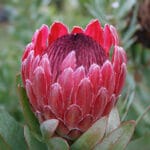Showing 493–504 of 2529 resultsSorted by popularity
-
Sale!

Protea Sharonet 15cm Pot
Original price was: R350.00.R179.99Current price is: R179.99.Add to cartProtea Sharonet 15cm Pot
Full Sun
Waterwise
Evergreen
Drought Tolerant
Low Watering
Indigenous -
Sale!

Chrysanthemum 15cm Pot
Original price was: R145.00.R84.99Current price is: R84.99.Add to cartChrysanthemum 15cm Pot
-
Sale!

Vachellia Xanthophloea 100lt
Original price was: R3,500.00.R1,999.99Current price is: R1,999.99.Add to cartVachellia Xanthophloea 100lt
Common Name: Fever tree (English), Koorsboom, Acacia XanthophloeFull Sun
Medium Watering
Indigenous
Wind TolerantThorn tree that grows up to 12m in height with paper=like bark and a flat spreading crown. They have light yellow flowers in Spring.
-

Flowering Cherry Tree 70lt
R4,200.00Select options This product has multiple variants. The options may be chosen on the product pagePrunus Serrulata 70lt
Common Name: Flowering Cherry TreeNOT FOR SALE OUTSIDE OF WESTERN CAPE
Choose From These Varieties (see pictures for flowering example)
Ichiyo
Kanzan
Prunus serrulata, commonly known as the Japanese cherry or Oriental cherry, is a species of cherry tree native to Japan, Korea, and China. It is widely cultivated for its beautiful and abundant flowers and is one of the most iconic species associated with cherry blossom festivals.Flowers
Colour: The flowers can be white to various shades of pink.
Type: Often double or semi-double, giving them a lush, full appearance.
Bloom Time: Typically in spring, usually late March to April depending on the climate.Leaves
Shape: Oval to lanceolate.
Colour: Emerges bronze in spring, matures to dark green in summer, and turns yellow to red in autumn.Growth Habit
Height: Can grow up to 7.0-9.0m tall.
Spread: Similar to its height, making it a broad, spreading tree.
Form: Has a rounded or vase-shaped crown.Bark
Appearance: Smooth with prominent horizontal lenticels.
Colour: Typically dark brown to reddish-brown.Growing Conditions
Soil: Prefers well-drained, fertile soil.
Light: Full sun to partial shade.
Water: Regular watering, especially during dry periods, though it is relatively drought-tolerant once established.
Climate: Thrives in temperate climates; cold hardy but can suffer in extremely hot and dry conditions.Landscaping Uses
Prunus serrulata is often planted in parks, gardens, and along streets for its ornamental value. It can be used as a specimen tree, in groups, or as part of a mixed border to create a dramatic spring display.Maintenance
Pruning: Minimal pruning required; best done after flowering to shape the tree and remove any dead or crossing branches.
Pests/Diseases: Susceptible to common pests like aphids and diseases like cherry leaf spot and powdery mildew. Regular monitoring and appropriate treatment can help maintain tree health. -
Sale!

Bougainvillea Sundown Orange 20lt
Original price was: R550.00.R425.00Current price is: R425.00.Add to cartBougainvillea Sundown Orange 20lt
Full Sun
Semi Shade
Low watering
Drought tolerant once establishedBeautiful climbing bougainvillea plant flowering with orange coloured flowers
-

Golden Showers Climbing Rose 5lt
R170.00Add to cartGolden Showers Climbing Rose 5lt
Full Sun
Afternoon Sun
Moderate Watering
Monthly Feeding
Prune in WinterClimbing roses are a type of rose that have a trailing growth habit and long canes that can be trained to climb or cascade over structures such as walls, fences, trellises, or pergolas.
They add vertical interest and a romantic charm to gardens and landscapes.Growth habit
Climbing roses are characterized by long, flexible canes that can reach varying heights, depending on the variety.
Some climbing roses can grow up to 6m or more. They have a natural tendency to climb and produce lateral branches along the canes. These lateral branches bear the flowers.Training and support
To train climbing roses, you will need to provide them with a support structure such as a trellis, arbor, pergola, or fence.
The canes can be gently tied to the support structure to encourage upward growth.
It is important to secure the canes loosely to prevent damage and allow for flexibility as they grow.Flowering
They typically produce an abundance of flowers, often in clusters or sprays.
The flowers can come in a variety of colors, including shades of red, pink, white, yellow, and even bi-colored or multi-colored blooms
Some climbing rose varieties also have a pleasant fragrance.Climbing roses can transform vertical spaces into stunning displays of color and fragrance.
Their ability to climb and cascade over structures adds a touch of elegance and beauty to any garden or landscape. With proper care and support, climbing roses can become striking focal points in your outdoor space. -

Cecile Brunner Climbing Rose 5lt
R175.00Add to cartCecile Brunner Climbing Rose 5lt
Full Sun
Afternoon Sun
Moderate Watering
Monthly Feeding
Prune in WinterClimbing roses are a type of rose that have a trailing growth habit and long canes that can be trained to climb or cascade over structures such as walls, fences, trellises, or pergolas.
They add vertical interest and a romantic charm to gardens and landscapes.Growth habit
Climbing roses are characterized by long, flexible canes that can reach varying heights, depending on the variety.
Some climbing roses can grow up to 6m or more. They have a natural tendency to climb and produce lateral branches along the canes. These lateral branches bear the flowers.Training and support
To train climbing roses, you will need to provide them with a support structure such as a trellis, arbor, pergola, or fence.
The canes can be gently tied to the support structure to encourage upward growth.
It is important to secure the canes loosely to prevent damage and allow for flexibility as they grow.Flowering
They typically produce an abundance of flowers, often in clusters or sprays.
The flowers can come in a variety of colors, including shades of red, pink, white, yellow, and even bi-colored or multi-colored blooms
Some climbing rose varieties also have a pleasant fragrance.Climbing roses can transform vertical spaces into stunning displays of color and fragrance.
Their ability to climb and cascade over structures adds a touch of elegance and beauty to any garden or landscape. With proper care and support, climbing roses can become striking focal points in your outdoor space. -

Salmon Panarosa Rose 5lt
R190.00Add to cartSalmon Panarosa Rose 5lt
Full Sun
Afternoon Sun
Moderate Watering
Monthly Feeding
Prune in WinterA rose panorama
Panarosas™ perform according to our set parameters of growing between 2m to 3m high and as wide with flowers on every cane.
They should be free standing informal shrubs and groups, hedges or specimen plants, and should provide a panorama of roses to the onlooker/spectator.
These roses can be planted on fences, at the periphery of a property or as a group in large lawns.
By training them up pillars and even over arches and pergolas, a neatness and floriferousness superior to that with traditional climbing roses can be achieved.The emphasis of this new group of roses is on uniformity of growth pattern.
The flower shape of the various varieties may be a typical hybrid tea rose, a semi double bloom or any of the charming shapes of yesterday’s roses – deep cup, quartered, frilled centre or pompom.
This rose group offers an almost full range of possible “rose” colours and many have a strong fragrance. -

Henri Delbard DELclaudibi Rose 5lt
R190.00Add to cartHenri Delbard DELclaudibi Rose 5lt
Full Sun
Afternoon Sun
Moderate Watering
Monthly Feeding
Prune in WinterA rose panorama
Panarosas™ perform according to our set parameters of growing between 2m to 3m high and as wide with flowers on every cane.
They should be free standing informal shrubs and groups, hedges or specimen plants, and should provide a panorama of roses to the onlooker/spectator.
These roses can be planted on fences, at the periphery of a property or as a group in large lawns.
By training them up pillars and even over arches and pergolas, a neatness and floriferousness superior to that with traditional climbing roses can be achieved.The emphasis of this new group of roses is on uniformity of growth pattern.
The flower shape of the various varieties may be a typical hybrid tea rose, a semi double bloom or any of the charming shapes of yesterday’s roses – deep cup, quartered, frilled centre or pompom.
This rose group offers an almost full range of possible “rose” colours and many have a strong fragrance. -

VodaRose Rose STD 90cm
R305.00Add to cartVodaRose Rose STD 90cm
Full Sun
Afternoon Sun
Moderate Watering
Monthly Feeding
Prune in WinterStandard roses, also known as lollipop roses, are a form of rose plant that is trained to have a long, straight trunk or stem with a rounded canopy of foliage and flowers at the top.
They are often used as standalone specimens in gardens or as focal points in landscaping.Growth habit
Standard roses are typically grafted plants where a desirable rose variety, known as the “scion,” is grafted onto a tall, straight stem of a different rose species or rootstock.
The stem is trained to grow straight and upright, creating a clear trunk without any side branches until it reaches a specific height.
At the top, the scion forms a rounded head or canopy of foliage and flowers.Height and size
The overall height of standard roses can vary depending on the desired size and how they are pruned.
Generally, standard roses can reach a height of 1 to 2m, with the canopy or head taking up a significant portion of the overall height.Pruning and maintenance
Regular pruning is essential to maintain the shape and size of standard roses. Pruning is typically done in early spring or late winter, before new growth emerges.
It involves removing dead, damaged, or weak wood, as well as shaping the canopy by selectively pruning the side branches.Flowering
Standard roses produce flowers at the top of the canopy, just like other rose varieties.
The flowers can come in various colors, forms, and fragrances, depending on the specific rose variety used as the scion.
They often bloom during the growing season, providing a beautiful display of color and fragrance.Uses
Standard roses are versatile and can be used in different garden settings. They are commonly planted in borders, formal gardens, or as standalone specimens in containers or garden beds.
Due to their vertical stature and the visual impact of the rounded canopy of flowers, they can serve as focal points in landscapes or create a dramatic effect when planted in groups.Varieties
Many rose varieties can be trained as standards, allowing for a wide selection of flower colors, forms, and fragrances.
Popular rose varieties often used as standard roses include hybrid teas, floribundas, and grandifloras.Standard roses, or lollipop roses, are eye-catching additions to gardens and landscapes. Their elegant form, long stems, and rounded canopy of flowers create a unique visual appeal.
With proper care, pruning, and attention, standard roses can bring vertical interest and beauty to any outdoor space. -

Happy Home Rose STD 90cm
R305.00Add to cartHappy Home Rose STD 90cm
Full Sun
Afternoon Sun
Moderate Watering
Monthly Feeding
Prune in WinterStandard roses, also known as lollipop roses, are a form of rose plant that is trained to have a long, straight trunk or stem with a rounded canopy of foliage and flowers at the top.
They are often used as standalone specimens in gardens or as focal points in landscaping.Growth habit
Standard roses are typically grafted plants where a desirable rose variety, known as the “scion,” is grafted onto a tall, straight stem of a different rose species or rootstock.
The stem is trained to grow straight and upright, creating a clear trunk without any side branches until it reaches a specific height.
At the top, the scion forms a rounded head or canopy of foliage and flowers.Height and size
The overall height of standard roses can vary depending on the desired size and how they are pruned.
Generally, standard roses can reach a height of 1 to 2m, with the canopy or head taking up a significant portion of the overall height.Pruning and maintenance
Regular pruning is essential to maintain the shape and size of standard roses. Pruning is typically done in early spring or late winter, before new growth emerges.
It involves removing dead, damaged, or weak wood, as well as shaping the canopy by selectively pruning the side branches.Flowering
Standard roses produce flowers at the top of the canopy, just like other rose varieties.
The flowers can come in various colors, forms, and fragrances, depending on the specific rose variety used as the scion.
They often bloom during the growing season, providing a beautiful display of color and fragrance.Uses
Standard roses are versatile and can be used in different garden settings. They are commonly planted in borders, formal gardens, or as standalone specimens in containers or garden beds.
Due to their vertical stature and the visual impact of the rounded canopy of flowers, they can serve as focal points in landscapes or create a dramatic effect when planted in groups.Varieties
Many rose varieties can be trained as standards, allowing for a wide selection of flower colors, forms, and fragrances.
Popular rose varieties often used as standard roses include hybrid teas, floribundas, and grandifloras.Standard roses, or lollipop roses, are eye-catching additions to gardens and landscapes. Their elegant form, long stems, and rounded canopy of flowers create a unique visual appeal.
With proper care, pruning, and attention, standard roses can bring vertical interest and beauty to any outdoor space. -

Easy Does It Rose STD 90cm
R305.00Add to cartEasy Does It Rose STD 90cm
Full Sun
Afternoon Sun
Moderate Watering
Monthly Feeding
Prune in WinterStandard roses, also known as lollipop roses, are a form of rose plant that is trained to have a long, straight trunk or stem with a rounded canopy of foliage and flowers at the top.
They are often used as standalone specimens in gardens or as focal points in landscaping.Growth habit
Standard roses are typically grafted plants where a desirable rose variety, known as the “scion,” is grafted onto a tall, straight stem of a different rose species or rootstock.
The stem is trained to grow straight and upright, creating a clear trunk without any side branches until it reaches a specific height.
At the top, the scion forms a rounded head or canopy of foliage and flowers.Height and size
The overall height of standard roses can vary depending on the desired size and how they are pruned.
Generally, standard roses can reach a height of 1 to 2m, with the canopy or head taking up a significant portion of the overall height.Pruning and maintenance
Regular pruning is essential to maintain the shape and size of standard roses. Pruning is typically done in early spring or late winter, before new growth emerges.
It involves removing dead, damaged, or weak wood, as well as shaping the canopy by selectively pruning the side branches.Flowering
Standard roses produce flowers at the top of the canopy, just like other rose varieties.
The flowers can come in various colors, forms, and fragrances, depending on the specific rose variety used as the scion.
They often bloom during the growing season, providing a beautiful display of color and fragrance.Uses
Standard roses are versatile and can be used in different garden settings. They are commonly planted in borders, formal gardens, or as standalone specimens in containers or garden beds.
Due to their vertical stature and the visual impact of the rounded canopy of flowers, they can serve as focal points in landscapes or create a dramatic effect when planted in groups.Varieties
Many rose varieties can be trained as standards, allowing for a wide selection of flower colors, forms, and fragrances.
Popular rose varieties often used as standard roses include hybrid teas, floribundas, and grandifloras.Standard roses, or lollipop roses, are eye-catching additions to gardens and landscapes. Their elegant form, long stems, and rounded canopy of flowers create a unique visual appeal.
With proper care, pruning, and attention, standard roses can bring vertical interest and beauty to any outdoor space.
